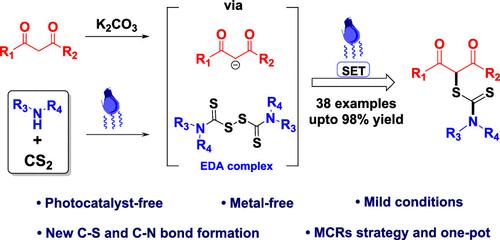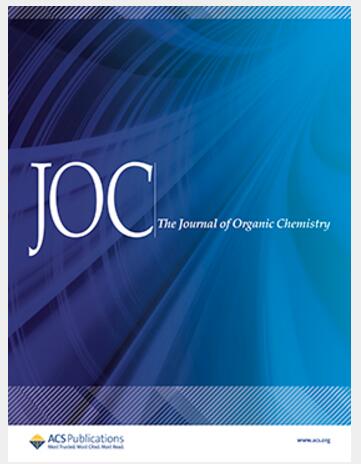双(二氨基硫代羰基)二硫化物作为电子受体在可见光下合成二硫代氨基甲酸酯衍生物的EDA配合物
IF 3.3
2区 化学
Q1 CHEMISTRY, ORGANIC
引用次数: 0
摘要
本研究提出了一种在可见光照射和无催化剂条件下将有害的CS2转化为二硫代氨基甲酸酯衍生物的绿色高效的原子和步骤经济方法。通过构建新的C-S和C-N键,一系列β-二羰基化合物和胺被纳入产物中。在光照下,CS2和胺首先形成双(二烷基胺硫羰基)二硫化物,然后与k2co3活化的β-二羰基化合物反应形成电子供体-受体(EDA)复合物,随后生成目标产物。本研究首次证实双(二烷基胺硫羰基)二硫化物可以作为电子受体与β-二羰基化合物形成EDA复合物,然后在光照下偶联形成目标产物。本文章由计算机程序翻译,如有差异,请以英文原文为准。

Bis(dialkylaminethiocarbonyl)disulfides Act as Electron Acceptors for EDA Complexes for the Synthesis of Dithiocarbamate Derivatives under Visible Light
This study proposes a green and efficient atom- and step-economical method for converting hazardous CS2 to dithiocarbamate derivatives under visible light irradiation and catalyst-free conditions. By the construction of novel C–S and C–N bonds, a series of β-dicarbonyl compounds and amines are incorporated into the products. Under light, CS2 and amine first form bis(dialkylaminethiocarbonyl)disulfides, which then react with K2CO3-activated β-dicarbonyl compounds to form electron donor–acceptor (EDA) complexes and subsequently generate the target products. This study confirms for the first time that bis(dialkylaminethiocarbonyl)disulfides can act as electron acceptors to form an EDA complex with β-dicarbonyl compounds, which are then coupled to form the target product under light.
求助全文
通过发布文献求助,成功后即可免费获取论文全文。
去求助
来源期刊

Journal of Organic Chemistry
化学-有机化学
CiteScore
6.20
自引率
11.10%
发文量
1467
审稿时长
2 months
期刊介绍:
Journal of Organic Chemistry welcomes original contributions of fundamental research in all branches of the theory and practice of organic chemistry. In selecting manuscripts for publication, the editors place emphasis on the quality and novelty of the work, as well as the breadth of interest to the organic chemistry community.
 求助内容:
求助内容: 应助结果提醒方式:
应助结果提醒方式:


